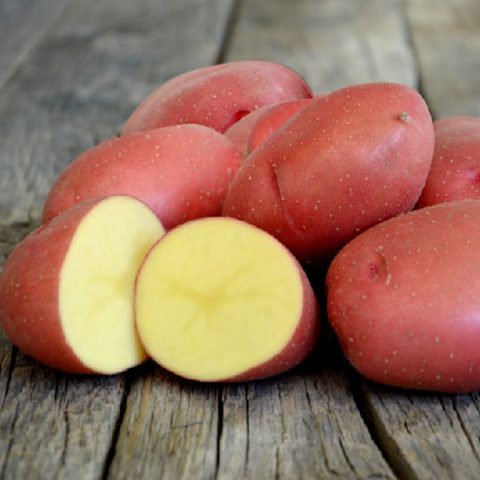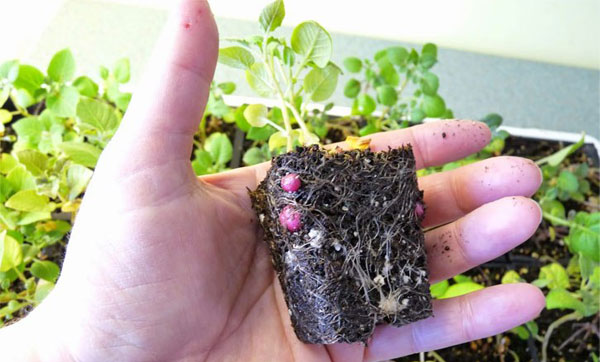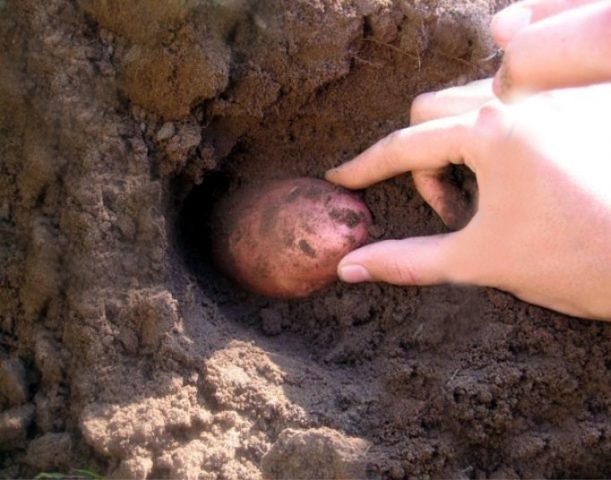Content
Description of the Krasa potato variety, photos and reviews show a valuable food crop of medium maturity. High resistance to pathogenic microflora allows the cultivation of tubers of high commercial and taste qualities. The Krasa potato belongs to a young selection and is characterized by productivity and stable yield. The tubers grow beautiful, round and large in size.
Description of the potato variety Krasa
Potato Krasa is a variety registered in the State Register of Breeding Achievements in 2017. Purpose: table. Recommended for cultivation in the Central region. In the description, Krasa potatoes are stated as mid-early, which means ripening within 80-100 days. The bush grows upright and grows in size from medium to tall. The leaf is dark green and large. The corollas are large. Inflorescences are red-violet.
Tubers with red skin, oval, elongated, small eyes. The pulp is light yellow, contains 13.5-15.6% starch. Tuber weight – from 95 to 110 g.In the characteristics and reviews, the Krasa potato variety is described as a crop with excellent marketability and keeping quality of tubers.
Taste qualities of potatoes
Krasa potatoes are characterized by excellent and good taste, depending on the growing conditions. A universal variety, potatoes are suitable for various types of culinary processing. Prepares quickly. When cooked, it does not change color and does not crumble. Contains vitamin C and other beneficial substances. The amount of starch is average.
Pros and cons of the Krasa variety
New selection varieties are being created with improved qualities. Including a variety in the State Register of Breeding Achievements guarantees a positive cultivation result. No deficiencies were found in the young variety.
Advantages of the variety:
- excellent taste;
- large, smooth tubers;
- consistently high productivity;
- bush resistance to lodging;
- resistance to diseases.
Positive qualities also include the availability of growing the Krasa variety from seeds. Botanical seeds of the crop are free from diseases, which makes it possible to obtain a high and high-quality harvest for many years.
Planting and caring for Krasa potatoes
It is recommended to grow potatoes of the Krasa variety with botanical seeds in seedlings. Propagation by seeds allows you to renew planting material. After all, it is known that after 5-6 years of growing a crop of the same variety, many diseases accumulate in the tubers and degeneration occurs. Botanical potato seeds do not accumulate pathogenic microflora.
The seedling method of growing potatoes is similar to the closely related nightshade crop - tomatoes. But in the first year of growing potatoes from seeds only provide planting material for the next season.
Stages of growing the Krasa variety from seeds:
- Potato seeds have a low germination rate, so they are pre-soaked for several days in a damp cloth for pecking.
- To increase immunity, the seeds are hardened by leaving them soaked overnight in the refrigerator at a temperature of +1°C, and for the day they are taken out and left at room temperature.
- Sowing begins in the last ten days of March.
- The potato root system forms slowly, so the soil must be highly fertile and loose.
- Before planting, the seeds, as well as the soil, must be disinfected in a fungicide solution. Potato seedlings are more often affected by a fungal disease, blackleg, than other nightshade crops.
- After the seeds have sprouted, they are laid out on moist soil without being buried. Even slightly buried seeds will not have enough growth force to emerge from under the soil.
- The crops are covered until germination, which will take from a week to two. Seedlings should always be in the most illuminated place.
- Watering is carried out with great care, from a small watering can along the edge of the container or using a pipette (syringe) next to the sprouts. You cannot spray crops with a spray bottle - this method can harm them.
- During the rooting period of seedlings, it is fertilized with ammonium nitrate.
- Potato sprouts are very small and thin and require the most careful handling, including at the time of picking, which is carried out at the stage of two true leaves.
Further cultivation of seedlings is possible in greenhouses or open ground.
Young plants are sensitive to low temperatures. Therefore, they are transferred to open ground when constant positive temperatures are established. At the beginning of growth, seedlings in open ground are covered with a film that protects them from temperature changes. Further agricultural technology for seedlings is the same as for potatoes grown from tubers.
Selection and preparation of a landing site
The place for planting Krasa potatoes is chosen on a hill with good lighting. Lowlands where moisture stagnates are not suitable for growing. In such an environment, the possibility of tuber rot and the occurrence of various fungal infections increases. The area for planting is prepared in advance, from the previous season.
Before planting, the soil must be enriched with organic matter or mineral fertilizers used. The soil for growing the Krasa variety should be light and slightly acidic.
The site is chosen where no crops of the nightshade family have grown before. This is especially important for planting pure plants from seeds. Fields after cabbage, zucchini and legumes are best suited.
Preparation of planting material
Krasa potatoes must be prepared before planting. This is necessary to accelerate germination and uniform growth of the crop. The first training is carried out in the fall. Before storing the seed potatoes for storage, they are calibrated and greened. Tubers of the same size allow seedlings to emerge at approximately the same time. And landscaping increases productivity by 20-30%.Krasa potatoes are greened for 2 weeks, leaving the selected tubers spread out in diffused light.
In the spring, 1-1.5 months before planting, the tubers begin to germinate in order to awaken their growth. To do this, the tubers are laid out in a bright, warm place. When sprouts appear, they are turned towards the light source. At the germination stage, it becomes possible to reject diseased tubers, for example, whose sprouts are black.
Before planting, the tubers are sprayed with a fungicide solution, which provides additional protection against possible diseases that may be in the soil.
Landing rules
Potatoes or their seedlings are planted in open ground when the soil has warmed to a depth of 10 cm or more to +7°C. The soil suitable for planting should be dry, not dirty, crumbly and light. The planting area must be clear of weed.
The planting depth in the hole is about 7 cm; the fruit is lowered downwards as seedlings. When planting seedlings and tubers, the distance between them is maintained at 70 cm.
Mineral or organic fertilizers can be added to the hole, depending on the initial soil fertility.
When applying fertilizers to the hole, they must be covered with soil and only then the fruit should be lowered. It should not come into direct contact with fertilizers. Mustard cake is considered an excellent organic fertilizer. It is superior in nutritional quality to manure. A handful of mustard cake is added to the hole and mixed with the soil.
Watering and fertilizing
During the dry period, on dry soil, potatoes produce a yield that is 2 times smaller. It is best to water in the furrows, increase during flowering and stop before harvesting.
The crop is demanding on soil fertility, which is fertilized in advance or during planting.
Loosening and weeding
Loosening and weeding are necessary to improve air exchange and the formation of high-quality, large tubers. Weeds have high growth vigor and a stronger root system. By clogging potato plantings, they draw moisture and nutrients onto themselves, especially during the first growing period.
Several weedings may be required per season, some of them combined with hilling. Weeds are removed manually or using manual and mechanical devices.
Hilling
Hilling is carried out several times during the growing season. To do this, the soil is raked under the potato bush until high ridges form. An alternative method to hilling is mulching potato bushes with grass. Mulching maintains the required level of moisture and eliminates the need for loosening and weeding.
Diseases and pests
Crops grown from depleted planting material, as well as with a lack of crop rotation, are more susceptible to diseases. The updated seed potatoes are genetically resistant to diseases and allow for a consistently good harvest for 5-6 years.
Potato variety Krasa is resistant to the following diseases:
- potato cancer;
- golden nematode;
- striped wrinkled mosaic;
- leaf curling;
- moderate to late blight of tubers and tops.
Pests that attack plant tops include:
- Colorado beetle;
- various flea beetles;
- caterpillars.
Tubers are damaged by the larva of the leaf beetle - wireworm, as well as beetle and mole crickets. Pests are selected manually, and biological products containing bacteria are used.And for large areas of infection, insecticides are used.
Potato yield
Potato yield directly depends on cultivation methods and climatic characteristics of the season. Under favorable conditions, Krasa potatoes form 6-8 even, large tubers from one bush.
Harvesting and storage
The Krasa potato harvest begins after 80-100 days, which occurs in the month of August. Signs that potatoes are ready for harvesting include drying of the tops and thickening of the skin. Harvest in dry, sunny weather. Potatoes have excellent shelf life when stored in dry rooms, at a temperature of +2... +4°C.
Conclusion
Description of the Krasa potato variety, photos and reviews represent a young crop selection with excellent characteristics. The producer of the variety suggests growing Krasa potatoes from seeds. This method allows you to obtain your own healthy planting material and high productivity.











